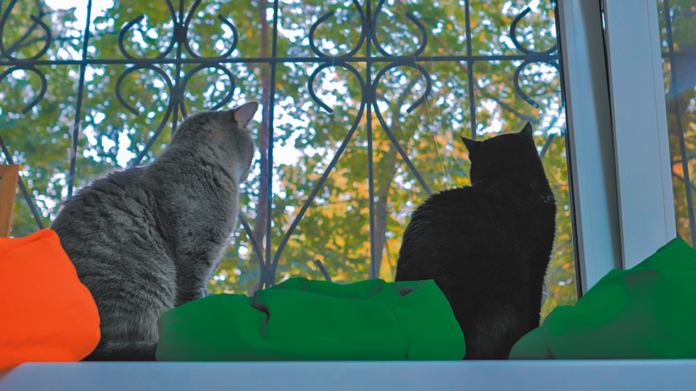If your cat starts biting or scratching you while you’re petting her, you immediately know she has had enough and stop. Or if she’s in pain and you go to tend to the affected spot and she swats you, you understand why she’s reacting aggressively. But there’s a much more common type of feline aggression that seems like it’s coming out of the blue, and “it’s the most likely to cause injury,” says the head of the Tufts Animal Behavior Clinic, Stephanie Borns-Weil, DVM.
Called redirected aggression, it occurs when a cat feels accosted by something she can’t do anything about and so lashes out at you instead in an effort to regain her equanimity. “There are no warning signals,” Dr. Borns-Weil says. “A cat is just at it all of a sudden. Sometimes a cat will literally fly at you and start biting and scratching. It seems like she is fighting for her life at that moment and is all out. It’s different from other types of aggression.” For instance, if you pet a cat for too long, she might warn you by just putting her teeth on you. But this tends to be uninhibited, uncontrolled.
It’s difficult to interpret. “People wonder what the heck is going on,” Dr. Borns-Weil says. ‘My cat is fine. My cat hates me. My cat is fine again.’ It’s really frightening because they don’t know what’s causing this unpredictable behavior. They are completely blindsided each time it happens.”
A cat might redirect aggression to another cat in the home, too. All of a sudden two feline buddies who have always gotten along famously are in a fierce physical battle because one of them has attacked the other, even though the other one hadn’t done anything.
Common triggers of redirected aggression
“Often, when clients come to see me, we work backwards to try to figure out what got the cat so aroused that she attacked, and it turns out it was some kind of noise,” Dr. Borns-Weil says. It could be music the cat found strange, or it could be the sound of an appliance — a food processor, vacuum cleaner, or some other loud machine. “The cat launched herself at the client because she was all of a sudden in a state of fear or arousal that she couldn’t manage. There was no warning signal.”
When a cat turns on another cat in the home, it’s often because the two are hanging around a perch by a window, and the cat has seen a cat outside. It arouses her territoriality — her desire to defend her turf — and she can’t get to the cat on the other side of the window, so she turns around and violently attacks the cat she loves. She truly forgets herself in the moment. It’s not like she knows she’s going after the wrong cat. She just wants to lash out at something to deal with what’s going on. Instinct gets out ahead of mental clarity. It’s incredibly shocking to the people in the home because the two cats normally curl up together for love fests. The fight appears seemingly out of nowhere.
Handling things in the moment
When a cat attacks and nothing has been going on between the two of you and you haven’t yet figured out what has caused the aggression, the best thing you can do is to separate yourself from your pet. “These are not learning moments,” Dr. Borns-Weil says. “Once a cat gets wound up like this, it will take her a while to calm down.”
That’s why if your cat is prone to these outbursts, it’s good to always keep a blanket nearby. That will help you escape into another room or shoo your cat into another room, so you can put a door between the two of you. It can take many hours before the cat calms down, not simply a few minutes. “After a few hours, you can push in a bowl of water, some food, and even a litter box,” Dr. Borns-Weil says. You don’t want your pet to become uncomfortable while she comes down from her heightened state of arousal.
When a cat in the throes of redirected aggression attacks a fellow cat, it’s imperative that you remove the attacked cat and keep the two felines entirely separated — to the point that the aroused cat can’t even stick her paw under the door. Put something in front of the door so she can’t approach it. The two cats need a clean, albeit temporary, break.
Then engage in a controlled reintroduction that could last anywhere from several weeks to several months. You might start by putting a cloth with the scent of the cat that has been attacked near the perpetrator’s food. Then, install an eye-hook on the door where you’re keeping the aggressor, and crack the door open. Let them see each other but not physically connect. You can work up to letting them chase the same feather from opposite sides of the doorway so they get used to each other again. You can even put the aggressive cat in a giant crate like the type used for large dogs and allow the victim cat to approach at her own speed.
But it really needs to be gradual. “The two cats may forget who started it,” Dr. Borns-Weil says, “so fear and readiness to fight is maintained on both sides. It becomes like the Hundred Years War if you don’t handle it carefully. Keep in mind that the aggressive cat doesn’t even understand what the other cat’s problem is. She believes she was attacking a cat she saw outside the window.”
Sometimes medicine can be useful in these situations to reduce underlying anxiety and fearfulness. In certain cases the doctor will prescribe a selective serotonin reuptake inhibitor (SSRI), or perhaps buspirone or another drug to help rebuild the bond between two house cats that are not able to calm down enough with human interventions alone.
Averting future attacks
In the case of a cat redirecting aggression onto you when she hears a noisy appliance or is aroused by some other event, it’s important to make sure your pet is away from you when the instigating event is about to occur. If you have to run the vacuum cleaner, turn on the blender, or do whatever else gets her going, make sure she is nowhere near.
When it comes to redirected cat-on-cat aggression, keep the shade down by the window that has a view of the interloper cat. Or move your cats’ window seat. It’s almost always a cat outside that makes a cat in the house turn on her housemate, so whatever it takes to keep the outdoor cat out of sight and out of sniffing range should resolve the issue.





Max keeps pooping outside the box.
Checked out health problems.
Inconsistent pattern…lol
Our senior indoor cat struck out at me twice, both times when she was on her window perch and saw a cat in the yard. It was scary; she was so out of control. She basically made a leap for my head, knocked off my glasses and smacked my eye. Thankfully the other cat never returned, perhaps run off by seven pounds of yowling, hissing fury. Our old girl was back to snuggling after about an hour.
My indoor cat reacted to the sight of just one particular cat outside by puffing out his tail and throwing himself against the glass with such force I thought he might harm himself, but he never turned on me. He was definitely out of control though. He was normally a very low key loveable pet.
Our two boys were best buddies, until we moved. The older one hid for 2 weeks, while the younger, a snowshoe Siamese, was exploring and claiming the new house. When the older cat reappeared, the younger seemed to say, “It’s mine — ALL mine!” And he attacked and tried to kill the older cat. After numerous vet visits and trying various medications, trial separation, reintroduction, etc., we gave up and permanently separated them. It was sad, but we were blessed to have the space in the house to keep them separate. That was 7 years ago. The older cat recently died, and the Siamese is now out in the whole house again. Sometimes you have to do the best you can with what you’ve got. We gave them both special attention every day and loved them dearly while they were apart, just as we did when they were together.
S has sent me to ER once, and attacked less viscously other multiple times. It’s always from some kind of sound. We use our paper shredder, coffee grinder, and blender in the garage only. I was terrified of him for months after the attack that precipitated the ER visit. I don’t have the heart to put him down, but he’s dangerous. The day is coming.
This just happened yesterday. The neighborhood feral was outside the screen door, and my older cat was hissing and growling at my younger cat, who was stunned and befuddled by the aggression. There was a bag nearby, which I grabbed and put between them. I shooed off the feral cat. Soon my older cat calmed down. She is normally a sensible and sweet cat. I knew she didn’t want to hurt him, and just couldn’t help herself. The younger cat is her “baby” – she mothered him when he was a kitten and they still groom each other and play well.